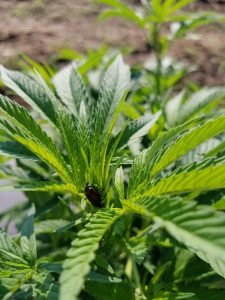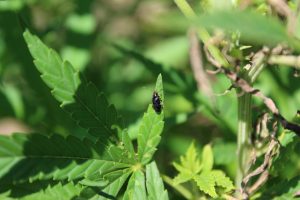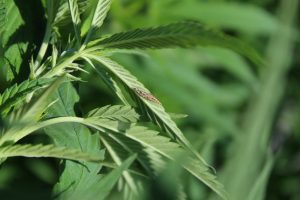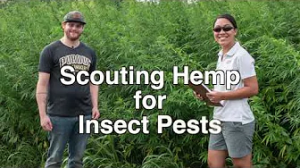Since hemp is still a relatively new crop in our state, we’re excited to learn more about the insect communities that are associated with this crop! For the last six weeks or so, my lab team, led by Master’s student Zach Serber (Figure 1), has been scouting outdoor CBD hemp plants for insects and their signs, including feeding damage, insect frass, and insect eggs!

Figure 1. Master’s student Zach Serber scouting hemp for insects and their signs. Photo by E.Y. Long
As “bug people” we’re always excited to go out on the hunt for insects, but in this case, we are scouting hemp plants for a specific purpose: to begin developing a seasonal picture of insect activity on outdoor hemp plants, particularly those insects that might be important pests. We know from hemp news in neighboring states that many kinds of insects visit hemp plants, including lively lady beetles, gymnastic grasshoppers, and hummin’ honey bees. However, finding an insect on a plant does not necessarily mean it is a damaging pest. So, here are a few observations of insects we’ve seen visiting and feeding on outdoor hemp plants, beginning June 30th through August 4th, 2020:
(Note: Ideally, we would have monitored hemp in indoor and outdoor settings at the same time, but constraints due to the pandemic this year forced us to focus only on monitoring hemp in outdoor settings).
Hemp visitors: The most conspicuous non-feeding insect we’ve seen on hemp plants this season are Japanese beetles (JBs) (Figure 2). We all know JBs well as fruit and leaf-feeding pests of many other crops, including small fruits, tree fruits, and ornamentals. However, the JBs we observed on outdoor hemp plants this season were around at the end of June for about 2 weeks, with no interest in the plants, besides a place to relax and soak up the sun!
Hemp leaf feeders: The red-headed flea beetle is perhaps the most interesting insect we’ve seen feeding on outdoor hemp plants this season; although I may think that only because I wasn’t expecting to see them! These beetles are solid black with a small red spot at the apex of head and of course, they are expert jumpers. They have a chewing feeding strategy and appeared to eat only the top layer of tissue from hemp leaves. Besides the red-headed flea beetles, we’ve also seen whiteflies, aphids, and thrips hanging out and feeding on hemp foliage. This latter group of insects have a piercing-sucking feeding strategy and sip on plant sap for a living. To be sure to see them, you must check the underside of hemp leaves where you will see them sitting, apparently motionless (aphids), crawling around quickly (thrips), or flying off in a cloud of tiny white wings (whiteflies). The flea beetles and whiteflies seemed to be more abundant earlier in our scouting, while aphids appear to be on the rise as the season get later.
Beneficial (predatory) insects: It’s always great to report that predatory insects are active in a crop, especially when you see pesky insects like aphids and thrips! This season, we’ve seen multi-colored Asian lady beetles (MALB), predatory thrips, damsel bugs, insidious flower bugs, and lacewing larvae (Figure 4) patrolling hemp stems and foliage for insect prey. These predatory insects feed on insect eggs and soft-bodied insects, including aphids, whitefly nymphs, and plant-feeding thrips. While the MALBs are relatively easy to spot, these other predatory insects are small and quite dainty, so you must look carefully and closely to see if they are present. For example, insidious flower bugs are roughly the size of a sesame seed, while lacewing larvae look like 2/3-inch alligators when mature. Regardless of their small size, these predatory insects are voracious and will search out and eat other soft-bodied insects!
Last but not least, with the help of our Extension Entomology team, we created a video demonstrating some key tips and strategies for scouting insects in hemp plantings! Check it out on the Purdue Extension Entomology YouTube page: https://youtu.be/1aO2IbcHmPY.
We hope the growing season has gone well for you, and as always feel free to reach out with any questions or suggestions for insect-related hotline articles!



